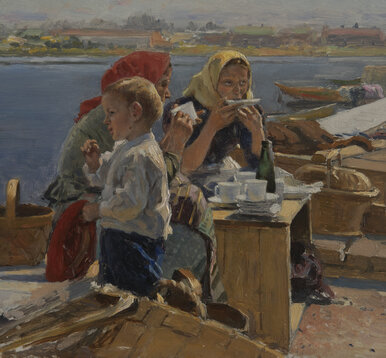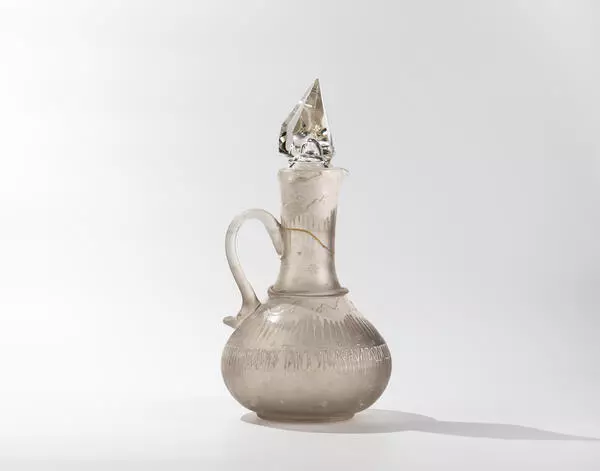The collection of the Ostrogozhsk Museum features a small painting by Elizaveta Boehm titled “Just Anything for My Dear — Even the Earring from My Ear”. In this watercolor portrait, the artist depicted the archetype which is so beloved by the Russian people. It resembles the image of Katyusha Maslova from the novel “Resurrection” by Leo Tolstoy.
Elizaveta Boehm was always interested in folk images. In this painting, she detailed the festive clothes and their texture with utmost care. She drew carefully all the ornaments, including the worsted yarn, bugle beads, embroidery in silk, and beadwork.
Elizaveta Merkurievna Boehm (née Endaurova) was born in St. Petersburg on February 12, 1843. Having graduated from the School of the Society for the Encouragement of the Arts with a silver medal in 1864, she started working on watercolor paintings and lithographic printing. One of her most distinguished mentors was Ivan Kramskoy. However, it was not the bright watercolor paintings that brought her worldwide fame, but her “simple black” drawings that she started creating in the 1870s. Elizaveta Boehm dedicated over 20 years to silhouettes and achieved virtuosity in this type of drawing. She also introduced her own ideas into this technique: she depicted the figures of people using silhouettes and drew all the surrounding objects with a feather quill.
Elizaveta Boehm decorated the works of Russian writers and folk tales with silhouettes, while her “black” drawings were often published in magazines and newspapers, participated in international exhibitions, and were awarded numerous medals. They were selling like hot cakes and became rarities at once. Her wonderful silhouettes are full of love and sincerity and still resonate with both children and adults.
Elizaveta Boehm was among the first artists to work on greeting cards. This genre helped her unlock her creativity as a watercolorist. She created albums using a pencil, a feather quill, and watercolor paints at the same time, and illustrated the poem “Red-Nosed Frost” by Nikolay Nekrasov (1872), as well as stories by Leo Tolstoy and Vsevolod Garshin. She also collaborated with such children’s magazines as “Igrushechka” (“Toy”, 1882–1886) and “Malyutka” (“Little Child”, 1886–1887), as well as the magazine “Niva” (“Grain Field”, 1875–1915). The artist used the silhouette technique to illustrate the fables of Ivan Krylov, “A Sportsman’s Sketches” by Ivan Turgenev, and the collections of Russian proverbs and sayings.
Elizaveta Boehm was always interested in folk images. In this painting, she detailed the festive clothes and their texture with utmost care. She drew carefully all the ornaments, including the worsted yarn, bugle beads, embroidery in silk, and beadwork.
Elizaveta Merkurievna Boehm (née Endaurova) was born in St. Petersburg on February 12, 1843. Having graduated from the School of the Society for the Encouragement of the Arts with a silver medal in 1864, she started working on watercolor paintings and lithographic printing. One of her most distinguished mentors was Ivan Kramskoy. However, it was not the bright watercolor paintings that brought her worldwide fame, but her “simple black” drawings that she started creating in the 1870s. Elizaveta Boehm dedicated over 20 years to silhouettes and achieved virtuosity in this type of drawing. She also introduced her own ideas into this technique: she depicted the figures of people using silhouettes and drew all the surrounding objects with a feather quill.
Elizaveta Boehm decorated the works of Russian writers and folk tales with silhouettes, while her “black” drawings were often published in magazines and newspapers, participated in international exhibitions, and were awarded numerous medals. They were selling like hot cakes and became rarities at once. Her wonderful silhouettes are full of love and sincerity and still resonate with both children and adults.
Elizaveta Boehm was among the first artists to work on greeting cards. This genre helped her unlock her creativity as a watercolorist. She created albums using a pencil, a feather quill, and watercolor paints at the same time, and illustrated the poem “Red-Nosed Frost” by Nikolay Nekrasov (1872), as well as stories by Leo Tolstoy and Vsevolod Garshin. She also collaborated with such children’s magazines as “Igrushechka” (“Toy”, 1882–1886) and “Malyutka” (“Little Child”, 1886–1887), as well as the magazine “Niva” (“Grain Field”, 1875–1915). The artist used the silhouette technique to illustrate the fables of Ivan Krylov, “A Sportsman’s Sketches” by Ivan Turgenev, and the collections of Russian proverbs and sayings.






